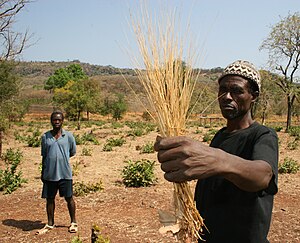Fonio

Fonio, also sometimes called Findo, is the term for two cultivated grasses in the genus Digitaria that are notable crops in parts of West Africa.[1] They are millets with small grains.[1]
Fonio is a nutritious food with a favorable taste.[1][2] It is consumed mainly in West African countries, where it is also cultivated.[1][2] The global fonio market was 673,000 tonnes in 2016.[3] Guinea annually produces the most fonio in the world, accounting for over 75% of the world's production in 2019.[4] The name fonio (borrowed into English from French) is from Wolof foño.[5]
In December 2018, the European Commission approved commercialization of fonio as a novel food in the European Union, after submission by the Italian company Obà Food to manufacture and market new food products.[6][7]

Types
White fonio
White fonio, Digitaria exilis, also called "hungry rice" by Europeans, is the most common of a diverse group of wild and domesticated Digitaria species that are harvested in the savannas of West Africa.[1] Fonio has the smallest seeds of all species of millet.[1] It has potential to improve nutrition, boost food security,[8] foster rural development, and support sustainable use of the land.[1]
Nutritious, gluten-free, and high in dietary fiber,[1][2][9] fonio is one of the world's fastest-growing cereals, reaching maturity in as little as six to eight weeks.[1] The grains are used to make porridge, couscous, bread, and beer.[1]
Black fonio
Black fonio, D. iburua, is a similar crop grown in several countries of West Africa, particularly Nigeria, Togo, and Benin.[1]
Cultivation and processing
Fonio grows in dry climates without irrigation, and is unlikely to be a successful crop in humid regions.[1] It is planted in light (sandy to stony) soils, and will grow in poor soil.[10] The growth cycle ranges from 70–130 days, depending on variety.[11] Fonio has C4 carbon fixation, like many other grasses. They are medium in height.[12] The ploidy level for the species range from diploid (2n), tetraploid (4n), to hexaploid (6n).[13]
Fonio is labor-intensive to harvest and process. Men and boys use sickles to cut down the fonio, which women then gather into sheaves and set out to dry.[14] Then it is threshed by spreading it on straw mats or tarps, typically by women using their feet. The grains are then washed by hand.[9]
The small grains make it difficult and time-consuming to remove the husk.[1] Traditional methods include pounding it in a mortar with sand, and then separating the grains and sand,[15] or "popping" it over a flame and then pounding it, which yields a toasted-color grain (a technique used among the Akposso).[1] The invention of a simple fonio husking machine offers an easier mechanical way to dehusk.[16]
See also
- Eragrostis tef, Teff – Edible annual grass native to the Horn of Africa
- Digitaria compacta – Species of grass also known as raishan
- Digitaria sanguinalis – Species of grass sometimes used as a crop
- Fonio husking machine – Invented by Senegalese Sanoussi Diakité
References
- ^ a b c d e f g h i j k l m n Fonio (Acha). In: Lost Crops of Africa: Volume I: Grains, Chapter 3, US National Academies Press. 1996. doi:10.17226/2305. ISBN 978-0-309-04990-0. Retrieved 22 December 2019.
- ^ a b c Levinson, Jessica (1 September 2018). "Whole grains: Fonio". Today's Dietitian. Retrieved 22 December 2019.
- ^ Sergey Avramenko (3 May 2018). "Guinea Is the Largest Producing Country of Fonio". IndexBox. Retrieved 22 August 2018.
- ^ "Fonio global production and top producing countries". Tridge. Retrieved 28 December 2021.
- ^ Seignobos, Christian; Tourneux, Henry (2002). Le Nord-Cameroun à travers ses mots: Dictionnaire de termes anciens et modernes: Province de l'extrême-nord (in French). Karthala Editions. p. 107. ISBN 2845862458.
- ^ "Fonio: EU Novel Food Approval". Official Journal of the European Union. European Commission. 18 December 2018.
- ^ Michail, Niamh (18 June 2018). "Italian firm Obà brings Fonio to Europe". Foodnavigator.com. Retrieved 22 December 2019.
- ^ "'Fonio just grows naturally': Could ancient indigenous crops ensure food security for Africa?". TheGuardian.com. 7 July 2022.
- ^ a b Heil, Emily (17 December 2019). "Is fonio the new quinoa? One chef hopes the tiny West African grain will be". Washington Post. Retrieved 21 December 2019.
- ^ "Cultivation / The plant - Fonio (Digitaria exilis)". fonio.cirad.fr. 2019. Retrieved 22 December 2019.
- ^ "The plant - Fonio (Digitaria exilis)". fonio.cirad.fr. 2019. Retrieved 22 December 2019.
- ^ Haq, N (1995). Fonio (Digitaria exilis and Digitaria iburua). London: Chapman & Hall. pp. 2–6.
- ^ Adoukonou-Sagbadja, H.; Schubert, V.; Dansi, A.; Jovtchev, G.; Meister, A.; Pistrick, K.; Akpagana, K.; Friedt, W. (2 July 2007). "Flow cytometric analysis reveals different nuclear DNA contents in cultivated Fonio (Digitaria spp.) and some wild relatives from West-Africa". Plant Systematics and Evolution. 267 (1–4): 163–176. doi:10.1007/s00606-007-0552-z. ISSN 0378-2697. S2CID 11184023.
- ^ "Postharvest technologies - Fonio (Digitaria exilis)". fonio.cirad.fr. Retrieved 22 December 2019.
- ^ "Traditional processing / Postharvest technologies - Fonio (Digitaria exilis)". fonio.cirad.fr. 2019. Retrieved 22 December 2019.
- ^ "Postharvest mechanization / Processing - Fonio (Digitaria exilis)". fonio.cirad.fr. 2019. Retrieved 22 December 2019.
Further reading
- "Fonio: an African cereal crop". CIRAD. Retrieved 21 April 2021.
- Portères, R. (1976). "African cereals: eleusine, fonio, black fonio, teff, Brachiaria, Paspalum, Pennisetum and African rice". In Harlan, J.R.; De Wet, J.M.J.; Stemler, A.B.L. (eds.). Origins of African plant domestication. The Hague: Mouton. pp. 409–452.
